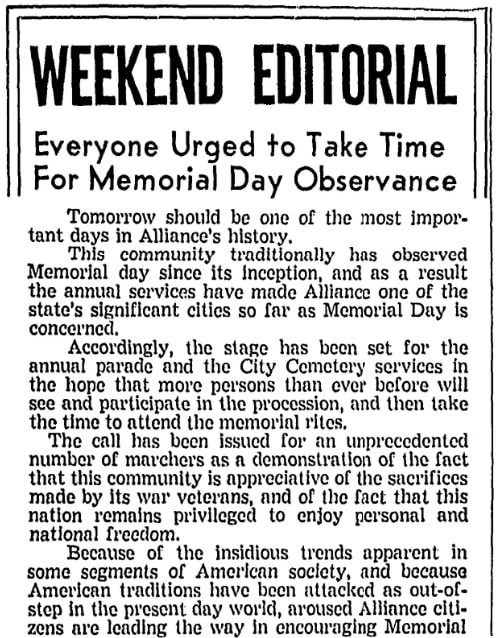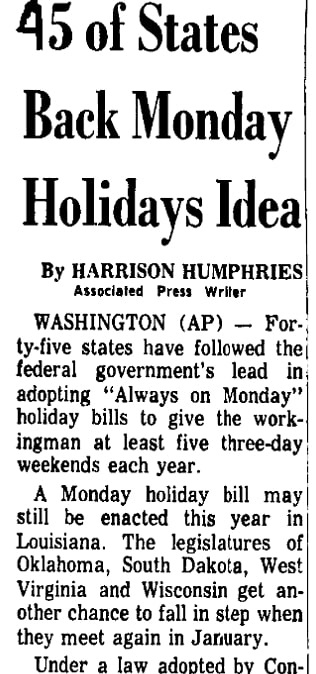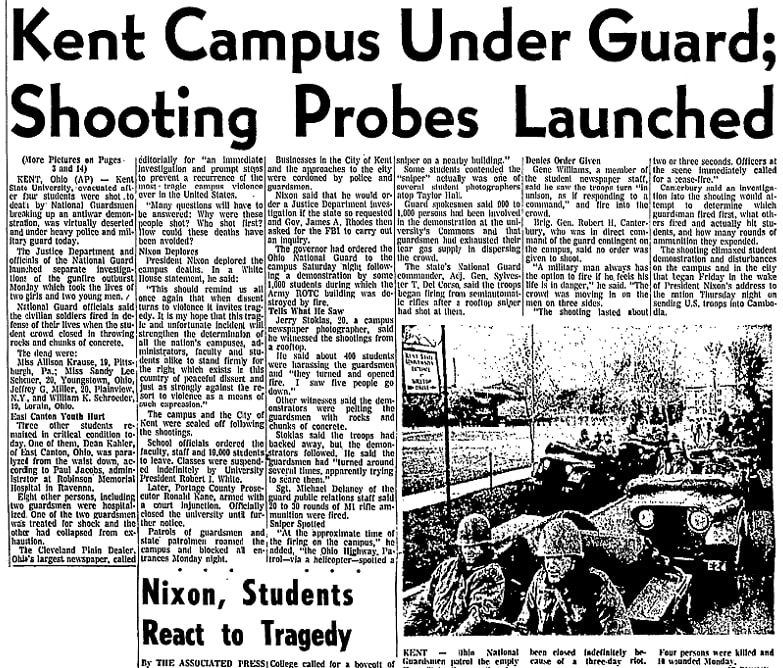Introduction: In this article, Jane Hampton Cook explores a newspaper editorial that added urgency to Memorial Day commemorations in 1970. Jane is a presidential historian and author of ten books, including Stories of Faith and Courage from the Revolutionary War. Her works can be found at Janecook.com. She is also the host of Red, White, Blue and You.
Sometimes a particular newspaper article catches your eye because of the emotion conveyed and the mystery it creates. Though a search for Memorial Day brings up numerous articles in GenealogyBank’s Historical Newspaper Archives, an editorial on 29 May 1970 in Alliance, Ohio, caught my eye because it conveyed an unusual sense of urgency and melancholy.
“Tomorrow should be one of the most important days in Alliance’s history,” Ohio’s Alliance Review began in the editorial, noting that Memorial Day services had been an important part of the Alliance community from the city’s beginning.

Yet, something seemed to have changed. What was it?
Nothing had changed about Alliance’s plans for Memorial Day. There would be a procession and cemetery service as usual.
“There is, therefore, an invitation to every man, woman and child to lay aside other interests – whether it be lawn tending, golfing or whatever – long enough to join in the Memorial Day observance,” the editorialist declared.
One thing that had changed was the recreational nature of holidays in America. For many years, the travel agencies and the transportation industry had lobbied Congress to place more holidays on Monday to enhance the tourism industry.
Congress had finally acquiesced and nationalized Memorial Day as the last Monday in May. Congress also placed other holidays on Mondays to give more long weekends to federal employees.

This article reported:
“Forty-five states have followed the federal government’s lead in adopting “Always on Monday” holiday bills to give the working man at least five three-day weekends each year.”
The new schedule was set to take place in 1971.
But this change doesn’t really explain why the organizers of Alliance, Ohio’s, 1970 Memorial Day activities hoped that more residents than ever before would participate in the ceremonies.
The Alliance Review editorial stated:
“The call has been issued for an unprecedented number of marchers as a demonstration of the fact that this community is appreciative of the sacrifices made by its war veterans, and of the fact that this nation remains privileged to enjoy personal and national freedom.”
The editorialist became bolder, as if under threat:
“Because of the insidious trends apparent in some segments of American society, and because American traditions have been attacked as out-of-step in the present-day world, aroused Alliance citizens are leading the way in encouraging Memorial Day participation.”
Memorial Day in Alliance had primarily focused on World War II in recent years. This editorialist was well aware that protesters opposing the Vietnam War had recently been vocal in their opposition to the war. This created a lot of heartache for World War II veterans.
“The feeling is that the chips are down and it is time for every loyal American, every Alliance citizen, to ‘stand up and be counted.’”
The editorialist also called on every resident and business to display an American flag:
“A profusion of flags in the parade and at the homes throughout the community, will serve as testimony to adherence to American principles, and as a warning to any doubters that Alliance and all of the United States continue to believe wholeheartedly in the freedom and liberties guaranteed by the U.S. Constitution.”
Then the editorialist ended with an astounding statement:
“There’s truth in the statement that joining in the Memorial Day observance ‘may be the most important thing you do in your lifetime.’”
Why would joining a Memorial Day parade in 1970 be the most important thing the residents of Alliance ever did in their entire lifetime?
Clearly something stronger and more emotional was driving this editorialist and the veterans organizing Memorial Day events in Alliance, Ohio, in 1970.
One sentence in the editorial gives an important clue:
“Current happenings should impress upon every American the need for a display of loyalty.”
What were those current happenings? The date of this editorial was 29 May 1970. Alliance, Ohio, is about a 30-minute drive from Kent, Ohio.
Twenty-five days earlier, on 4 May 1970, four Kent State University students were killed and nine were injured after members of the Ohio National Guard opened fire on unarmed Vietnam War protesters there.
The headline in the Alliance Review the next day declared “Kent Campus Under Guard; Shooting Probes Launched.”

In the weeks that followed the shooting, students across the nation had led a strike, forcing the temporary closing of colleges and universities.
For the Alliance Review editorialist and World War II veterans in Ohio, Memorial Day in 1970 took on a new urgency. Tragedy had struck their state and the nation to its core. Fresh grief, shock, and a sense of patriotism guided their desire that year to honor their nation and war veterans, those who had fought for the rights of the Kent State protesters and other Americans to peacefully assemble and protest their government as outlined in the First Amendment.
For war veterans in 1970, Memorial Day was a time to renew their pledge of allegiance to America in Alliance.
Note on the header image: photo of the Tomb of the Unknown Soldier located in Arlington National Cemetery, Virginia. Credit: Raul654; Wikimedia Commons.
Related Articles:
